2016 Activity Report for Mission 5-1: Harmonization of Human Health and the Environment
Updated: 2017/05/10
< Bioactive compounds>
Research1-1: Survey of antiviral compounds from wood and bamboo vinegar (Takashi Watanabe)
Joint studies on antiviral compounds from wood and bamboo vinegars have been conducted, with the goal of contributing to human health and life by producing medicinal and biologically active substances from unutilized biomass. In FY2016 we identified versatile phenol derivatives and elucidated the antiviral activity of each. We revealed the effects of substituents attached to the aromatic skeleton on antiviral activity. Lanzhou Veterinary Research Institute and RISH have started a joint study on the antiviral activity of wood and bamboo vinegar against FMDV.
An international workshop on bioactive compounds from plant resources will be held on March 6, 2017 at the Uji campus of Kyoto University. Collaborative studies will be discussed with experts in livestock viruses, livestock endocrinology, and other fields from various research organizations including Lanzhou Veterinary Research Institute, Nanjing Agricultural University, and Tokyo University of Agriculture and Technology.
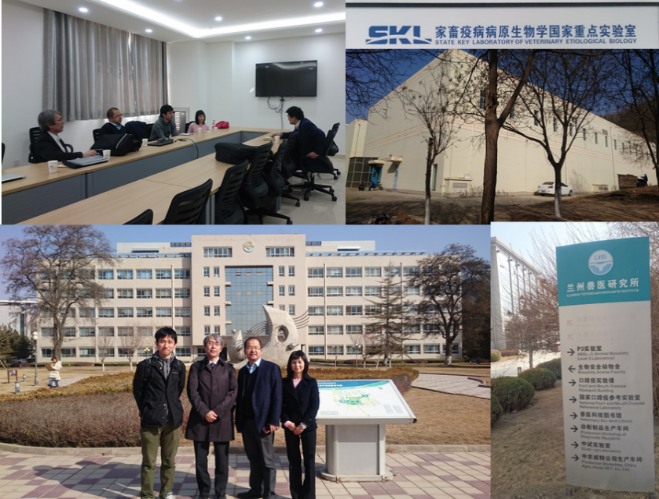
Lanzhou Veterinary Research Institute and RISH are conducting international collaborative studies on the antiviral activity of wood and bamboo vinegar.
Research1-2: Production mechanism of bioactive compounds and biotechnology (Kazufumi Yazaki)
Many plant secondary metabolites utilized in clinical fields (such as vincristine and paclitaxel) show hydrophobic features and are often secreted from cells. The secretion mechanism of such lipophilic metabolites is, however, largely unknown. This study focuses on the secretion mechanism by using Lithospermum erythrorhizon as a model system.
- A system for monitoring shikonin derivatives was established in cultured hairy roots of L. erythrorhizon by confocal laser microscopy.
- Inhibitor experiments showed that a common pathway for vesicle secretion is, at least in part, involved in shikonin derivative secretion.
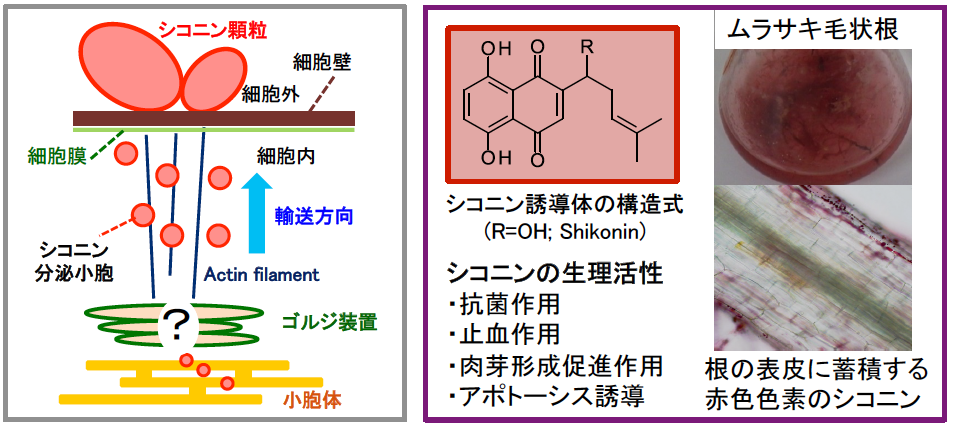
Publications, etc.
Tatsumi K., et al., Characterization of shikonin derivative secretion in Lithospermum erythrorhizon hairy roots as a model of lipid-soluble metabolite secretion from plants, Frontiers Plant Sci. 7, Article 1066, 2016.
Research1-3: Establishment of unit reaction for biological production of antitumor lignans (Toshiaki Umezawa)
Podophyllotoxin is a pharmacologically important compound that has received much attention. It is used as a precursor for the chemical synthesis of anticancer drugs. However, sources of podophyllotoxin are becoming increasingly scarce in nature. As a result, its availability and biosynthesis have become the main focus of many researchers. In this study, we isolated and characterized cDNAs encoding enzymes such as OMTs involved in podophyllotoxin biosynthesis. We are working on the isolation of a gene encoding lignan O-methyltransferase using Anthriscus sylvestris (Apiaceae) and Thujopsis dolabrata (Cupressaceae).
Publications, etc.
- Kumatani M, Yamamura M, Ono E, Shiraishi A, Umezawa T. Identification of enzyme gene involved in the methylation of 5-O-methylthujaplicatin in Anthriscus sylvestris. 34th JSPCMB (2016) in Ueda, Japan. (Oral)
- Kumatani M, Yamamura M, Ono E, Shiraishi A, Umezawa T. Exploring of a gene involved in antitumor lignan biosynthesis in Anthriscus sylvestris. 67th JWRS (2017) in Fukuoka, Japan. (Oral)

Proposed biosynthetic pathways for antitumor lignans
Research1-4: Insect model to discover physiologically active substances in biomass (plants and microorganisms) – searching for gene resources though grooming behavior – (Aya Yanagawa)
Animals groom themselves or each other. It appears, for example, that leg shaking in humans is a grooming behavior. Hence, the factors involved in grooming regard important to abnormal behaviors from stress or cardiac disorders. We would like to contribute medical treatments that can ease abnormal behaviors by clarifying the genes or chemical factors involved in grooming using an insect model.
(Collaborators: Coby Schal, Trudy Mackay, Ayako Katsumata, Akihiko Yamamoto, Wen Huang)
Research Activities
- Spontaneous grooming analysis on 203
fully sequenced inbred lines of Drosophila to identify the related genes. - Upcoming second research meeting/seminar at North Carolina State University, USA (March 2017).
- Presentation at the JSCPB symposium, “Environmental Sensing and Animal Behavior”, Tokyo, (June, 2016).
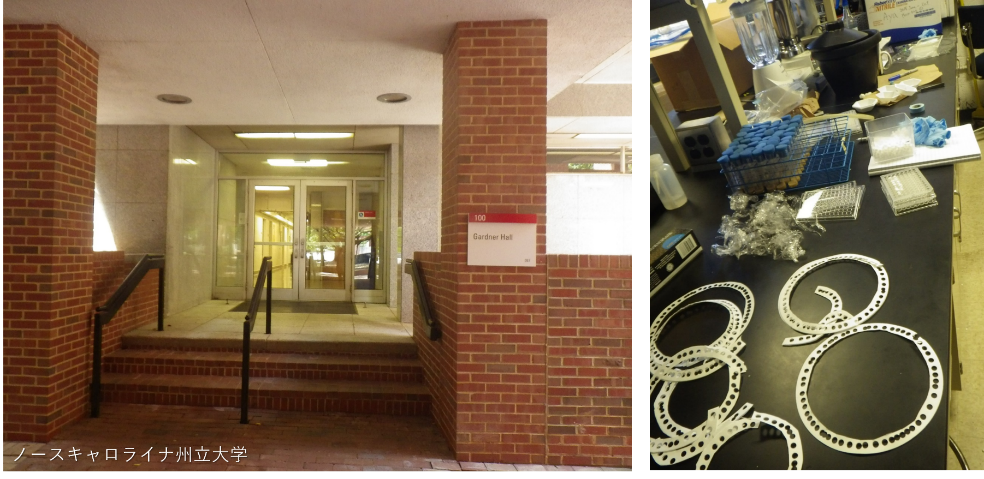
North Carolina State University and RISH are conducting international collaborative studies
Publications, etc.
Yanagawa, A., French, A., Hata, T., Yoshimura, T., Marion-Poll, F. Decapitated test to see the microbe induced grooming response, JSCPB symposium, “Environmental Sensing and Animal Behavior”, June 2016, Tokyo, Japan. (Invited lecture.)
Research2: Biological effects of electromagnetic fields (Junji Miyakoshi)
There exists a wide variety of non-ionizing radiation (electromagnetic fields, EMF) in human living environments. There is increasing international discussion about the health risks of EMF exposure. We performed a risk assessment of EMF exposure using cellular and genetic examinations.
- Biological safety assessment of environmental EMF (millimeter waves, terahertz frequencies) fields.
- Biological safety assessment of EMF from wireless power transfer systems in human living environments.
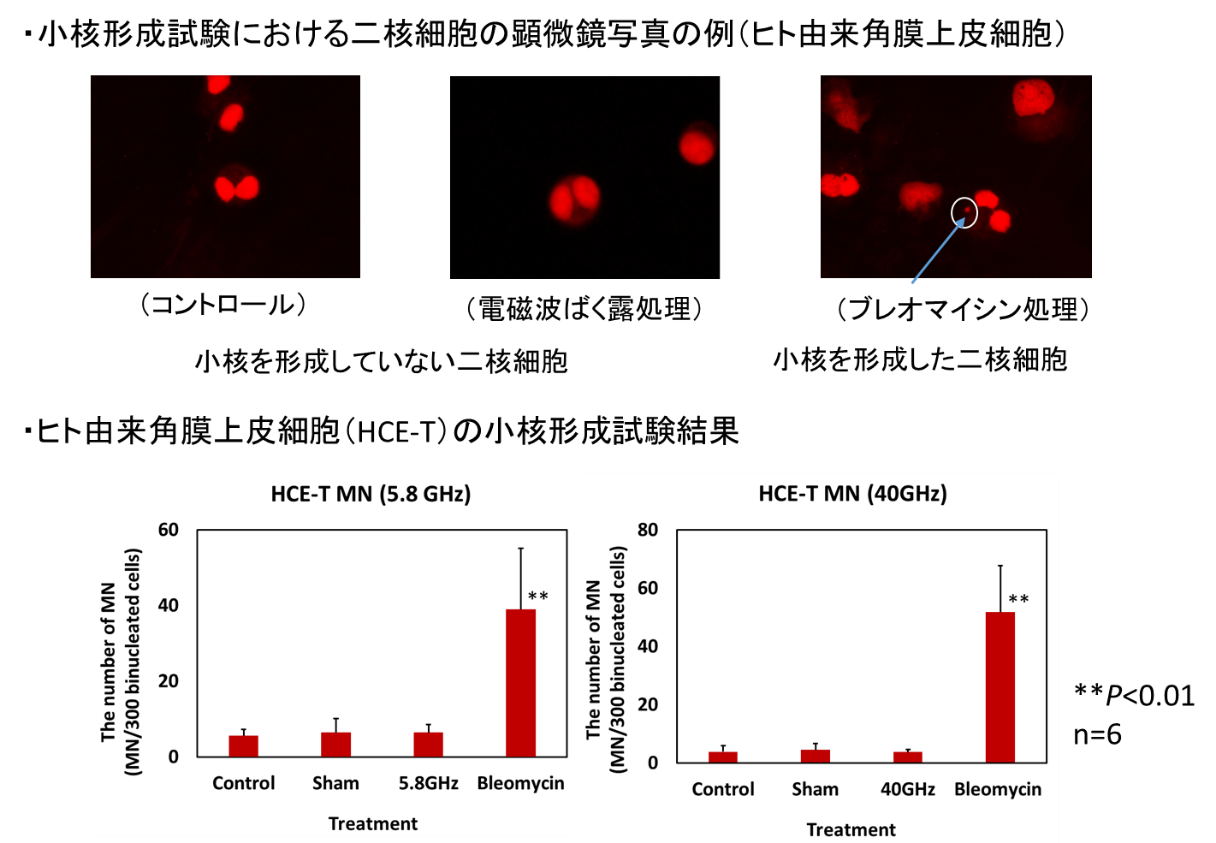
Society
- Bioelectromagnetic Society (BioEM)
- URSI-GA
- AP-RASC, etc.
Publications, etc.
- S. Koyama, E. Narita, Y. Shimizu, T. Shiina, M. Taki, N. Shinohara, and J. Miyakoshi, Twenty four-hour exposure to a 0.12 THz electromagnetic field does not affect the genotoxicity, morphological changes, or expression of heat shock protein in HCE-T cells, Int. J. Environ. Res. Public Health, 13, 793; doi:10.3390/ijerph13080793, 2016.
- S. Koyama, E. Narita, Y. Shimizu, Y. Suzuki, T. Shiina, M. Taki, N. Shinohara, and J. Miyakoshi, Effects of long-term exposure to 60 GHz millimeter-wavelength radiation on the genotoxicity and heat shock protein (Hsp) expression of cells derived from human eye, Int. J. Environ. Res. Public Health, 13, 802; doi:10.3390/ijerph13080802, 2016.
- K. Mizuno, N. Shinohara, and J. Miyakoshi, In vitro evaluation of genotoxic effects under magnetic resonant coupling wireless power transfer, Int. J. Environ. Res. Public Health, 12, 3853-63. doi: 10.3390/ijerph120403853, 2015.
- K. Mizuno, E. Narita, M. Yamada, N. Shinohara, and J. Miyakoshi, ELF magnetic fields do not affect cell survival and DNA damage induced by ultraviolet B, Bioelectromagnetics, 35, 108-15. doi: 10.1002/bem.21821, 2014.
- Junji Miyakoshi, Cellular and molecular responses to radio-frequency electromagnetic fields, Proc. IEEE, 101, 2013.
- J. Miyakoshi, Electromagnetic fields and health, RF World, No. 35, p. 107-115. http://www.rf-world.jp/bn/RFW35/RFW35A.shtml. 2016 (Review). (in Japanese)
- S. Koyama, J. Miyakoshi, Recent research regarding the cellular response to radiofrequency radiation, Journal of the National Institute of Public Health, 64(6), 547-554, 2015 (Review). (in Japanese)
For more details on this issue, please visit http://space.rish.kyoto-u.ac.jp/people/miyakoshi/
Research3: Air quality issues in outdoor and indoor environments (Kenshi Takahashi and Masanori Yabuki)
Human activities increasingly influence the Earth’s climate and ecosystems. For instance, humans change the atmospheric aerosol loadings by emitting primary aerosol particles and a variety of trace gases that could be chemically transformed to give aerosol particles. Aerosol particles impact the Earth’s climate on a regional and global scale. Our study aims to develop in-situ and remote sensing techniques for observing trace gases and aerosol particles and their applications to outdoor and indoor measurements, which is closely linked to air quality issues in outdoor and indoor environments.
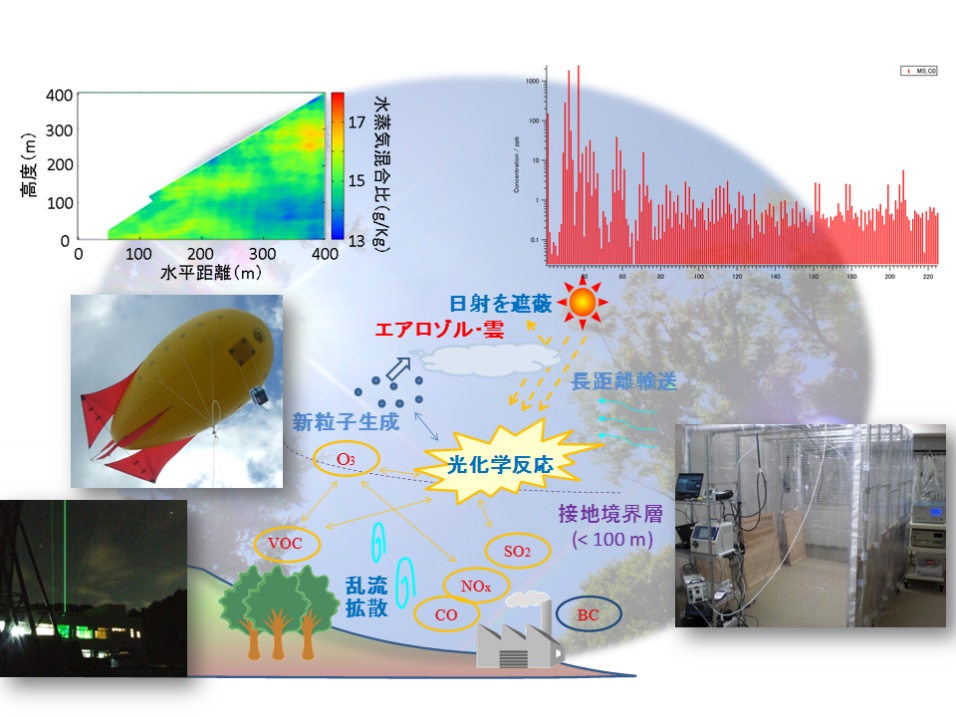
Development of new techniques for exploring spatio-temporal variations of atmospheric trace molecules and aerosol particles in outdoor and indoor environments.
Publications, etc.
M. Yabuki, M. Matsuda, T. Nakamura, T. Hayashi, and T. Tsuda, A scanning Raman lidar for observing the spatio-temporal distribution of water vapor, J. Atmos. and Solar-Terres. Phys., 150, 21–30, 2016.


